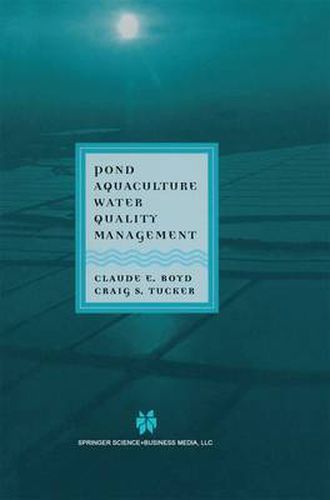Readings Newsletter
Become a Readings Member to make your shopping experience even easier.
Sign in or sign up for free!
You’re not far away from qualifying for FREE standard shipping within Australia
You’ve qualified for FREE standard shipping within Australia
The cart is loading…






This title is printed to order. This book may have been self-published. If so, we cannot guarantee the quality of the content. In the main most books will have gone through the editing process however some may not. We therefore suggest that you be aware of this before ordering this book. If in doubt check either the author or publisher’s details as we are unable to accept any returns unless they are faulty. Please contact us if you have any questions.
The efficient and profitable production of fish, crustaceans, and other aquatic organisms in aquaculture depends on a suitable environment in which they can reproduce and grow. Because those organisms live in water, the major environ mental concern within the culture system is water quality. Water supplies for aquaculture systems may naturally be oflow quality or polluted by human activity, but in most instances, the primary reason for water quality impairment is the culture activity itself. Manures, fertilizers, and feeds applied to ponds to enhance production only can be partially converted to animal biomass. Thus, at moderate and high production levels, the inputs of nutrients and organic matter to culture units may exceed the assimilative capacity of the ecosystems. The result is deteriorating water quality which stresses the culture species, and stress leads to poor growth, greater incidence of disease, increased mortality, and low produc tion. Effluents from aquaculture systems can cause pollution of receiving waters, and pollution entering ponds in source water or chemicals added to ponds for management purposes can contaminate aquacultural products. Thus, water quality in aquaculture extends into the arenas of environmental protection and food quality and safety. A considerable body of literature on water quality management in aquaculture has been accumulated over the past 50 years. The first attempt to compile this information was a small book entitled Water Quality in Warmwater Fish Ponds (Boyd I 979a).
$9.00 standard shipping within Australia
FREE standard shipping within Australia for orders over $100.00
Express & International shipping calculated at checkout
This title is printed to order. This book may have been self-published. If so, we cannot guarantee the quality of the content. In the main most books will have gone through the editing process however some may not. We therefore suggest that you be aware of this before ordering this book. If in doubt check either the author or publisher’s details as we are unable to accept any returns unless they are faulty. Please contact us if you have any questions.
The efficient and profitable production of fish, crustaceans, and other aquatic organisms in aquaculture depends on a suitable environment in which they can reproduce and grow. Because those organisms live in water, the major environ mental concern within the culture system is water quality. Water supplies for aquaculture systems may naturally be oflow quality or polluted by human activity, but in most instances, the primary reason for water quality impairment is the culture activity itself. Manures, fertilizers, and feeds applied to ponds to enhance production only can be partially converted to animal biomass. Thus, at moderate and high production levels, the inputs of nutrients and organic matter to culture units may exceed the assimilative capacity of the ecosystems. The result is deteriorating water quality which stresses the culture species, and stress leads to poor growth, greater incidence of disease, increased mortality, and low produc tion. Effluents from aquaculture systems can cause pollution of receiving waters, and pollution entering ponds in source water or chemicals added to ponds for management purposes can contaminate aquacultural products. Thus, water quality in aquaculture extends into the arenas of environmental protection and food quality and safety. A considerable body of literature on water quality management in aquaculture has been accumulated over the past 50 years. The first attempt to compile this information was a small book entitled Water Quality in Warmwater Fish Ponds (Boyd I 979a).